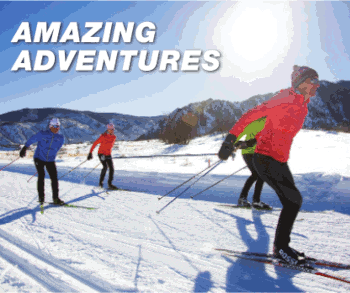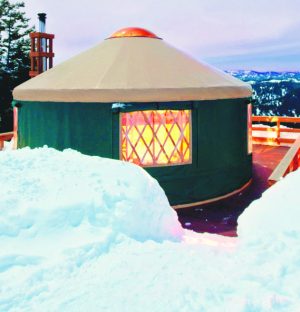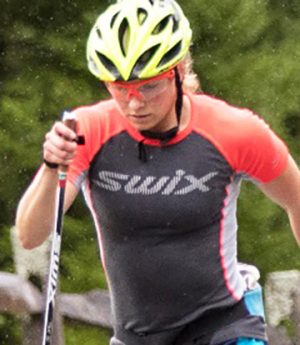December 27, 2013 (Alaska) – This summer in July, Norwegian National team member, Astrid Jacobsen, hooked up with Kikkan Randall and the US XC Ski Team as a special guest of the NAWTA camp in Alaska. It was the second time the camp hosted an international skier – last year Aino-Kaisa Saarinen of Finland made the journey. The camp includes a week of dry land training, and a week of on-snow training on Eagle Glacier and Jacobsen shared her thoughts and insights with us on the camp, the US team, and how to become the fastest women skiers on the planet.
I am just a normal girl. A girl that likes to do things according to plan, likes to be liked, and does whatever is expected of me. I guess you can draw the picture… so please keep that in mind when you think about the fact that I skipped all of my summer plans and jumped on a plane – direction Alaska.
It was kind of an “out-of-the-box” experience for me. Of course my adventure over the big pond wasn’t made in a hurry. But the Norwegian National Team training and camp schedules are so excessive that usually there aren’t any openings to go anywhere other than home to clean your clothes, pay your bills and prepare for the next one.
When we finished the 2012/13 WC-season in Falun in March I talked with Liz [Stephen] and Kikkan [Randall] about meeting up during summer and training together. Like every year at the final WC, the atmosphere was relaxed and easy as all athletes saw the end of a long winter with tough competitions and massive travelling. It would not be the first time loose agreements and dreams were shared, without ever getting close to reality.
The events in Falun came and went, and after a 5-hour drive I was home in Oslo, diving into three months of full time med-school. The following month I was very close to finishing my skiing-career, as I felt it was time for me to do something new with my life. I felt I had done the WC-ski scene for so many years that it had turned more into more of a habit than a passion. At least I questioned my passion… that is who I am and being tough with myself. I am probably my hardest judge, always trying to be better, to evolve and develop, and do something meaningful. At that time skiing didn’t feel so important to me anymore.
But it was just another phase. I was still a skier, I just needed to learn something new. And this new learning didn’t have to be something academic such as the anatomy or fancy medical treatments. Suddenly I realized that I knew almost nothing about how other teams ran their programs or how or why my fellow WC-skiers kept their motivation up for training towards an Olympic season. I could feel a curious spirit within myself, which led to an email sent to Kikkan. I more or less invited myself to Alaska for summer training, including the NAWTA camp. The response was very welcoming, coming from a passionate and (I suspect) surprised Kikkan.
Why the US Ski team? I think many people consider the Norwegian team as the best in the world of cross-country skiing. Yes, we have the best results over the last years. You may wonder how a nation of only 5 million people can produce so many top-athletes. It comes down to traditions and culture. Snow, wintersports and especially cross-country skiing has long and strong roots within in Norway. A popular sport with strong role models has provided a good recruitment system and young, fast skiers keep popping up all over the country.
But why are Norwegians fast? We have a culture of training smart and in a playful environment with high quality starting at quite a young age. People in Norway just ski a lot, and they share new knowledge to ensure continuous development of the team. The best Norwegian skiers today are a product of all the top skiers we have had over the last decades. I had Bente Skari as a role model, she showed me the standard of what it means to be a top cross-country skier.
So, who showed Kikkan and Liz… and the US ski team? They have all had phenomenal progress over the last years, skiing at a higher and higher levels, even setting new standards in the sport in some areas. That was probably the biggest reason why I got on that plane, taking my first ever trip to the US. I was curious about how a group of girls could overcome much bigger obstacles than I ever had, to be fast skiers and earning more and more podiums on the WC.
Of course I had some ideas; seeing them support and encourage each other, smiling and crying together, thousands of miles away from home. I wondered how they had managed to make a new and nourishing culture helping relatively young girls blossom a continent away from their safe environment at home.
Arriving in Alaska directly from a massive camp with my own team was a risk concerning my own health and shape. But I was always confident that stepping into something unknown would give me a challenge and kick to my motivation that I would not be able to find at home. I admit that my coaches were skeptic of taking all that time between camps 10 time zones away from home, and being worried that I would be exhausted for the August camp. But, even if I am a “normal girl” that likes to be friends with everyone and do as I am told, I was confident that this adventure would give me more than I would lose. And when I decide anything, I am quite determined.
Three weeks is a long time. You can get so much done in three weeks. I just imagined how many books I could get through during the last three weeks before an exam…
But the three weeks I spent in Alaska went so fast, that I still wonder where all the days went. Dryland-training began in Anchorage with Kikkan and the APU team during the first days before the rest of the US women’s team flew in. The following 14 days saw 15 eager girls training, living, eating, sleeping and talking together. The actual training program was really close to what we do in our camps. Some differences can always to be found, like the strong focus the US team has on high speed and sprints in skating, putting specific training in the plan every week.
In this area I see that my own team is actually falling behind in the development of the sport. It is easy to see that Kikkan’s strong qualities have spread to the rest of the group. I took some of these aspects into my own training at home during fall, and maybe I will have developed in these areas by the time we hit February and the Olympic Games begin.
The plans are similar, the athletes are devoted and motivated, the coaches present directing young and fresh athletes, the atmosphere inspiring… including the respect for each individual and a strong role model. We have Marit Bjørgen, they have Kikkan Randall. I can find so many similarities between our teams, though there are also some differences which is perhaps the reason why the Norwegians still are a bit faster. I already mentioned the tradition and the big recruitment programs we have.
But, the group of athletes that makes up the US team today is for sure packed with so many qualities and dedication that they can evolve into the fastest skiers in the world. They have the motivation and the passion. They have the surroundings, at least Anchorage showed me great areas for rollerskiing, running, strength training, summer skiing and altitude training (Eagle Glacier). They have the devoted coaches that work day and night for their athletes, though on a very limited budget. They have the knowledge about physiology. And they have the dreams.
But maybe they are missing a few things. In my opinion this team would benefit hugely from a strong classic-skier, helping the rest to reach a higher level, like Kikkan has done in high-speed skating. And within all the passion and dedication in this team, comes also the need for some discipline. In our team we are much more strict with intensity, controlling pulse and lactate both in L1 and L3 training. Especially when training at altitude.
The fact remains that it is still harder for us to go slow, than to go fast – we are always eager to take a new step. But sometimes it is best not to push the limits. When we do L3-intervals at home we never go together in a group because history has told us that someone will always push too hard when we ski in a pack. At the NAWTA Camp we did all intervals together in one big group, making the load of the workout completely different from athlete to athlete, depending on everyone’s level and shape that day. At this high level you don’t really have the time to miss the target and purpose of any single training session.
I think it is possible for the US women to be a big and strong team while maintaining the characteristics of the group, taking care of all the great energy that lies within all athletes, and still have some individuality in the training. To take the last, and the hardest step to the top, you can’t do everything together, eventhough that is what is most fun. Each athlete needs to find their own limits, training to go alone at their own speed. That will make a disciplined but happy skier, who is well aware of their strong and weaker sides.
I brought home so much inspiration from my trip overseas. I can’t even count how many people I met that were so welcoming and I have to send a big THANK YOU to Kikkan and her husband Jeff for taking me in for two weeks of their summer. I am also grateful that the US ski team and the APU club let me join their training, showing me around Anchorage and sharing everything that can possibly be shared at a ski camp.
I hope I can return the favour, hosting some of my new American friends here in Norway! The adventures in Alaska went so fast that I never really wanted to go home (which is first time ever!). Returning to my own team in August my shape was better than ever and my spirits were high. I don’t know what you fed me over there, but it worked. You have all inspired a normal girl to step out of her comfort-zone and be apart of your big dreams and love for the sport!
Let it be a great year and a memorable Olympics for us all!
Astrid
- Jacobsen joins APU at the NAWTA camp. © courtesy of Kikkan Randall
- The Alaskan girls take Jacobsen fishing. © courtesy of Kikkan Randall
- Astrid JAstrid Jacobsen and the APU ladies reach new heights. © courtesy of Kikkan Randallacobsen and the APU ladies reach new heights. © courtesy of Astrid Jacobsen
- Astrid Jacobsen and Kikkan Randall on the trail. © courtesy of Astrid Jacobsen
- Astrid Jacobsen grocery shopping American style. © courtesy of Kikkan Randall
- Astrid Jacobsen joins APU's NAWTA camp. © courtesy of Kikkan Randall
- Astrid Jacobsen trains in Alaska. © courtesy of Kikkan Randall
- Astrid Jacobsen preparing a well-earned feast. © courtesy of Astrid Jacobsen preparing a well-earned feast. © courtesy of Kikkan Randall
- Astrid Jacobsen on deck. cooking up a storm © courtesy of Kikkan Randall
- Astrid Jacobsen fueling up for more quality training in AK. © Kikkan Randall






![National camp action [P]...](https://skitrax.com/wp-content/uploads/2019/08/Duluth-4-2019-08-08-at-10.46.51-AM-300x246.png)
![Matt Liebsch on the CXC Elite Team [P] CXC...](https://skitrax.com/wp-content/uploads/2019/08/Matt-Liebsch-CXC.2-525x700.4-300x267.jpg)
![Dan LaBlanc [P]...](https://skitrax.com/wp-content/uploads/2019/08/Dan-LaBlanc-img_1855.3.jpg)

![Astrid Jacobsen (l) and Kikkan Randall in AK. [P] courtesy of Kikkan Randall](http://skitrax.com/wp-content/uploads/2013/12/IMG_2101.2.jpg)
![Jacobsen joins APU at the NAWTA camp. [P] courtesy of Kikkan Randall](http://skitrax.com/wp-content/uploads/2013/12/IMG_0509.2.jpg)
![Jacobsen and the APU ladies reach new heights. [P] courtesy of Kikkan Randall](http://skitrax.com/wp-content/uploads/2013/12/IMG_0561.2.jpg)
![Randall (l) and Jacobsen make a pit stop [P] courtesy of Kikkan Randall](http://skitrax.com/wp-content/uploads/2013/12/IMG_2080.2.jpg)
![The Alaskan girls take Jacobsen fishing. [P] courtesy of Kikkan Randall](http://skitrax.com/wp-content/uploads/2013/12/IMG_0540.2.jpg)
![Jacobsen goes grocery shopping a la American. [P] courtesy of Kikkan Randall](http://skitrax.com/wp-content/uploads/2013/12/IMG_2110.2.jpg)
![Jacobsen says she didn't want to go home... [P] courtesy of Kikkan Randall](http://skitrax.com/wp-content/uploads/2013/12/IMG_2147.2.jpg)
![Astrid Jacobsen on deck cooking up a storm... [P] courtesy of Kikkan Randall](http://skitrax.com/wp-content/uploads/2013/12/IMG_2172.2.jpg)
![Jacobsen joins APU at the NAWTA camp. [P] courtesy of Kikkan Randall](https://skitrax.com/wp-content/uploads/2013/12/IMG_0509.2-125x125.jpg)
![The Alaskan girls take Jacobsen fishing. [P] courtesy of Kikkan Randall](https://skitrax.com/wp-content/uploads/2013/12/IMG_0540.2-125x125.jpg)
![Astrid JAstrid Jacobsen and the APU ladies reach new heights. [P] courtesy of Kikkan Randallacobsen and the APU ladies reach new heights. [P] courtesy of Astrid Jacobsen](https://skitrax.com/wp-content/uploads/2013/12/IMG_0561.2-125x125.jpg)
![Astrid Jacobsen and Kikkan Randall on the trail. [P] courtesy of Astrid Jacobsen](https://skitrax.com/wp-content/uploads/2013/12/IMG_2080.2-125x125.jpg)
![Astrid Jacobsen grocery shopping American style. [P] courtesy of Kikkan Randall](https://skitrax.com/wp-content/uploads/2013/12/IMG_2110.2-125x125.jpg)
![Astrid Jacobsen joins APU’s NAWTA camp. [P] courtesy of Kikkan Randall](https://skitrax.com/wp-content/uploads/2013/12/IMG_2120.2-125x125.jpg)
![Astrid Jacobsen trains in Alaska. [P] courtesy of Kikkan Randall](https://skitrax.com/wp-content/uploads/2013/12/IMG_2147.2-125x125.jpg)
![Astrid Jacobsen preparing a well-earned feast. [P] courtesy of Astrid Jacobsen preparing a well-earned feast. [P] courtesy of Kikkan Randall](https://skitrax.com/wp-content/uploads/2013/12/IMG_2156.2-125x125.jpg)
![Astrid Jacobsen on deck. cooking up a storm [P] courtesy of Kikkan Randall](https://skitrax.com/wp-content/uploads/2013/12/IMG_2172.2-125x125.jpg)
![Astrid Jacobsen fueling up for more quality training in AK. [P] Kikkan Randall](https://skitrax.com/wp-content/uploads/2013/12/IMG_2240.2-125x125.jpg)
December 27th, 2013 at 1:56 pm
Only one thing to say about these thoughts and ideas—it is a tremendous piece of writing filled with all kinds of wise evaluations—I hope there are open ears listening. Astrid has a great way of expressing her thoughts, and you could feel it right away in the first paragraph.
Well done Astrid—-and the best in the New Year for a great Olympics.
December 27th, 2013 at 3:54 pm
This has been one of the best articles I have ever read in/on Skitrax!
Thank you!
Kk
December 27th, 2013 at 7:41 pm
I heartily agree with Marty and Kamil about the article. Thank you Astrid for writing such an insightful, wise and honest appraisal of your experience with the Women’s U.S. Ski Team. So refreshing to hear the outside perspective about some of the strengths and weaknesses of the U.S. Ski Team.
Best of luck to you in 2014 and at the Olympic Winter Games in Sochi!
Cheers,
Tim